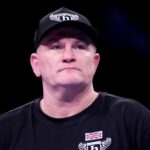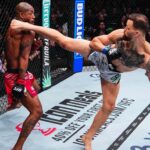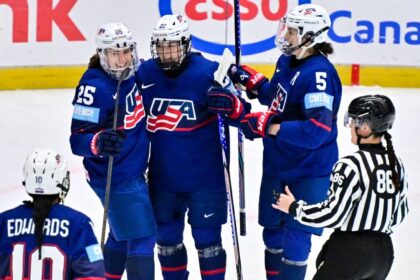NHL Market Heats Up: Analysis of the First Moves
The NHL offseason is already underway, and trades have begun to pile up since the Florida Panthers lifted the Stanley Cup for the second consecutive season. Alofoke Deportes brings you the analysis of the most important market movements.Among the notable moves, Chris Kreider heads to the Anaheim Ducks, Trevor Zegras joins the Philadelphia Flyers, and Noah Dobson is traded to the Montreal Canadiens. Here are the grades for each of these moves.
June 27: Coyle to the Blue Jackets
The Colorado Avalanche, seeking cap space, made a move on Friday by trading Charlie Coyle and Miles Wood to the Columbus Blue Jackets. In return, the Blue Jackets sent prospect Gavin Brindley, a 2025 third-round pick, and a conditional 2027 second-round pick to Colorado.Colorado Avalanche
Grade: B+
The Avs secured a center for the second line by signing Brock Nelson to a three-year contract extension at $7.5 million annually. This left the Avs with only $1.2 million in cap space. Since the Avs have several unrestricted free agents, they needed to do something. Coyle was a strong candidate to be traded. His arrival gave the Avs one of the best center dynamics in the NHL, behind Nathan MacKinnon and Nelson. However, when a team faces a salary cap crisis, does it make sense to pay a third-line center $5.25 million annually when there are more team-friendly options? Wood was another possible candidate to be traded, given the remaining four years with an AAV of $2.5 million. Injuries and inconsistencies led him to score only 13 goals in the last two seasons with the Avs. This also leaves the Avs needing to address their forwards from the last six, as well as possibly retaining Lindgren, along with anything else they seek to accomplish in free agency. It’s possible Brindley could help with that at some point in the future. The 20-year-old player was one of the top prospects in the Blue Jackets’ farm system, which is one of the strongest in the NHL. Brindley scored six goals and 17 points in 52 games.Columbus Blue Jackets
Grade: B+
The Blue Jackets have so much cap space that they can choose which deals make sense, especially if it involves working with a team that needs to create cap space like the Avs. Coyle and Wood were a luxury in Colorado, but in Columbus they will strengthen the last six, which will allow the front office to focus on other places in free agency. Entering Friday, the Blue Jackets had six unrestricted free agent forwards, while Dmitri Voronkov is a restricted free agent. Adding Coyle gives them a third-line center with Sean Monahan and Adam Fantilli on the top two lines. Wood gives them a winger who can be used on the fourth line (or potentially higher); in total, the Jackets now have 13 forwards who are under contract or under team control as RFAs. They also have over $30 million in cap space, with the idea that some of that could be used on extensions for Dante Fabbro and Ivan Provorov. Brinkley was one of their best prospects, but the Blue Jackets still have promising forwards in their system, including Cayden Lindstrom, Jordan Dumais, and Luca Del Bel Belluz.June 27: Dobson to the Canadiens
Defenseman Noah Dobson was the focus of a trade on Friday between the Montreal Canadiens and the New York Islanders, with the idea that both franchises are heading in different directions. The Canadiens acquired Dobson after he signed an eight-year contract extension worth $9.5 million annually with the Islanders on Friday. New York obtained forward Emil Heineman and both of the Canadiens’ 2025 first-round picks, numbers 16 and 17.Montreal Canadiens
Rating: A
If there’s an opportunity to get a 25-year-old defenseman, who plays right-handed, shoots, from the first line, who moves the puck and can play in all scenarios, who is also packaged in a 6-foot-4-inch body, that’s a move a general manager should make. But, it is done with the full understanding that it will cost quite a bit, and that is what makes the decision of the Canadiens’ general manager, Kent Hughes, quite emphatic due to what he points out about his team. Specifically, Montreal is serious about making its appearance in the 2025 playoffs a regular occurrence, with the goal of winning the Stanley Cup in the near future. Future. That is the word at the heart of what this exchange represented for the Canadiens. Having two first-round picks is a benefit. For rebuilding teams, it’s an opportunity to build towards what they believe is a stronger future, while playoff teams, or those on the cusp, use them as trade chips to acquire someone who can improve them now. Hughes took the last option with this agreement, and it provides Montreal with what appears to be one of the most attractive young defensive lineups in the NHL. Dobson, who has scored 10 or more goals in four consecutive seasons, joins a group of young Canadiens defensemen that includes current Calder Trophy winner Lane Hutson, Kaiden Guhle, and Jayden Struble. The Habs also have recent first-round picks Logan Mailloux and David Reinbacher in their system. That’s six defensemen, all under 25 years old. Four of them are first-round picks, while the rest were second-round picks (including Hutson). This is what’s called a problem. Or rather, it has the potential to create a problem because of what that collection could achieve over time. But then there’s the real “problem” facing Hughes now that he has Dobson under contract, in the sense that the Habs are now $3.394 million over the salary cap (according to PuckPedia), while they have seven defensemen under contract or team control for 2025-26. This will force Hughes to decide which Montreal defenseman leaves to free up cap space, while also having the necessary group to push for the aforementioned playoffs. Veteran Mike Matheson has one year remaining on his contract at $4.88 million before becoming an unrestricted free agent, while Alexandre Carrier has two years remaining at $3.75 million annually before hitting the open market. Handling that situation as soon as possible allows the Habs to gain more financial flexibility in case they want to do more, although they also have a couple of RFAs in Struble and Jakub Dobes who need new deals.New York Islanders
Rating: A
The new Islanders general manager, Mathieu Darche, spent six seasons in the Tampa Bay Lightning front office, which allowed him to appreciate the value of certain elements. One of them is the value of building a long-term winner through the draft. General managers running lottery teams need a level of honesty and understanding about the direction of their franchise. That’s what makes anything the Islanders do in Darche’s first offseason even more critical. That doesn’t mean Dobson couldn’t have been part of those long-term plans on Long Island. But there’s also something to be said for identifying the strongest possible value a player has for his franchise, and determining that this value is greater with a return like the one Darche obtained here. What Darche received in exchange for a first-line defenseman in Dobson will play an important role in shaping the Islanders for the next decade, if not more. Having the number 1 selection was a starting point towards that future, and it is likely that he will add talented defenseman Matthew Schaefer with that selection. But by adding two more first-round selections, he has even more options. Darche and his staff could decide they want to keep both picks they acquired from the Canadiens and draft three players. After all, they would be adding more to a system that, despite having 2024 first-round pick Cole Eiserman, clearly needs talent. Part of the reason for that is that the Isles have had four draft classes since 2018 (2020, 2021, 2022, 2023) in which they didn’t have a first-round pick. ¿Will Darche seek to repackage one or both of those selections in another trade, hoping to do something more that he and his staff believe can prepare them for even greater long-term success? Although the future is in the spotlight, there’s also something to be said about the present and what it means now that Dobson is gone. The Islanders now have five defensemen under contract and seven under team control, with a couple of pending RFAs in Scott Perunovich and Alexander Romanov. Tony DeAngelo and Mike Reilly are UFAs from the 2024-25 roster. The Islanders have $20.934 million in cap space (according to PuckPedia), which can be used to address their defensive needs along with anything else they need to handle this summer; that includes re-signing Heineman, who is an RFA after scoring 10 goals and 18 points in 62 games during his first full NHL season.June 26: Peterka to the Mammoth
Two of the storylines to follow this NHL offseason were whether the Utah Mammoth could add at least one top-six forward to their roster, and whether the Buffalo Sabres would part ways with restricted free agent JJ Peterka. On Wednesday night or Thursday morning, depending on the time zone, those narratives collided, with the Mammoth acquiring Peterka in a trade with the Sabres, with forward Josh Doan and defenseman Michael Kesselring going to western New York. Let’s see how both headquarters acted in this exchange, as well as what it means for each franchise in the future.Utah Mammoth
Rating: A+
In 2024-25, the Utah Hockey Club was a top-10 team in terms of shot attempts, shots per 60 minutes, and scoring chances per 60, but finished 16th in goals per game. So there was a disconnect. With $20.357 million in cap space, a solution to that problem needed to be found.And what is the latest significant move by Mammoth’s general manager, Bill Armstrong? Signing Peterka in the trade, and then immediately signing him to a five-year extension worth $7.7 million annually.
Since Ryan and Ashley Smith bought the franchise and moved the team to Salt Lake City, the Mammoth have adopted a strategic but aggressive approach. It began last year when they traded for a legitimate number 1 defenseman in Mikhail Sergachev along with John Marino as part of a plan to revamp their blue line. Peterka is a continuation of that need to make another big splash. In doing so, the Mammoth add a proven 23-year-old goal scorer who not only addresses their need for more goals, but also fits into their long-term plans. After scoring 28 goals and what was then a personal best of 50 points in 2023-24, Peterka responded with 27 goals and 68 points in 77 games in what would be his final season in Buffalo. Exchanges can often be about creating more options for a team, and Peterka gives the Mammoth plenty. They now have a top-six group of wingers that also includes Clayton Keller, Dylan Guenther, and Nick Schmaltz. That amounts to a quartet of 20-goal scorers to play with centers Logan Cooley and Barrett Hayton, who also scored more than 20 goals last season, anchoring those top two lines. Armed with what is considered one of the strongest farm systems in the NHL, the Mammoth didn’t have to part with any of their top prospects to get Peterka. They still have Matias Maccelli, whom they could look to move in another trade, and they still have $14.982 million in cap space, according to PuckPedia. Nick Bjugstad and Michael Carcone are their most notable unrestricted free agents, while Jack McBain remains their only restricted free agent. After getting a difference-making player at number 4 overall in the draft on Friday, or using that selection to acquire another NHL-ready player, they will be able to use most of that remaining salary space to be active in free agency on July 1st.Buffalo Sabres
Grade: B-
The most appropriate word one could use to describe what Sabres general manager Kevyn Adams received in return for Peterka? Complicated.
In general, a top-six forward aged 23 or under who remains under team control will hypothetically attract a certain price. Somehow, the Sabres were able to get that by receiving a pair of NHL players in Doan and Kesselring. But it can be argued that the Sabres didn’t receive enough. Missing the playoffs for the last 14 seasons has left the Sabres in the space between trying to end that drought, while keeping an eye on the future in case plans need to change (again). Although the Sabres have one of the strongest farm systems, the Peterka trade presented them with an opportunity to add more, either through draft capital or prospects. That’s especially true when the player at the center of the deal was so important to the Sabres, given that he was second on the team in points, third in goals, third in power-play points, and third in ice time among forwards with more than 70 games. It’s not that Adams left empty-handed. Doan could carve out a spot as a top-nine forward. Joining the Sabres is an opportunity for Doan to find the consistency that eluded him in Utah. He played 28 games in the AHL last season, in addition to the 51 games he played for the Hockey Club. Kesselring gives the Sabres a third right-shot defenseman on their roster. He finished with more than 20 points, while recording more than 70 games, in consecutive seasons. He was also sixth among Mammoth defensemen in average ice time; like Doan, he could see a more important role in Buffalo. Doan and Kesselring give the Sabres depth. They will also cost the club a total of $2.325 million in cap space, as both players have one year remaining on their respective contracts before restricted free agency. The Sabres now have $20.881 million in cap space, according to PuckPedia. However, it still begs the question: Was a forward from the bottom six/middle six and a middle pairing defenseman (at best) enough return for a top-six forward? Or should Adams have gotten more for a player who is addressing one of the Mammoth’s biggest needs, while leaving themselves needing to fill a considerable hole on the roster?June 23: Zegras to the Flyers
The rumor finally became reality on Monday with the Anaheim Ducks trading forward Trevor Zegras to the Philadelphia Flyers. The Ducks traded Zegras, who has long been discussed as a possible trade target, to the Flyers for forward Ryan Poehling, a 2025 second-round pick (originally belonging to the Columbus Blue Jackets) and a 2026 fourth-round pick. What does all this mean, and how did both headquarters do?Philadelphia Flyers
Grade: B+
“Potential” is the word that will be used most to describe this exchange. It starts with the fact that Zegras gives the Flyers another top-nine center, in addition to what they already have with Sean Couturier and Noah Cates, with the idea that Zegras has the potential to become their first-line center. Zegras is a two-time 20-goal scorer who has also authored a pair of consecutive 60-point seasons. That could give the Flyers, who finished 24th in goals per game, another player who can score while creating opportunities for those around him. At 24 years old, he also potentially fits into the Flyers’ long-term plans. The Flyers were the youngest team in the NHL in 2024-25, with an average age of 26.09 years, according to Elite Prospects. Once again, the keyword here is potentially. Injuries and inconsistencies over the last two seasons created doubts about whether Zegras could return to being the player who had those consecutive 60-point seasons in 2021-22 and 2022-23. Furthermore, they led to questions about whether he would return to or surpass those totals while remaining with the Ducks. Surrounding Zegras with wingers like Tyson Foerster, Travis Konecny, Matvei Michkov, and/or Owen Tippett could get him back on track. After all, at one point, Zegras was among the league’s breakout stars and seemed poised to become one of the future faces of the NHL. He was chosen as the cover athlete for NHL 23. Then there’s the added incentive that Zegras is in the final season of a three-year contract worth $5.75 million annually. He will remain under team control as a restricted free agent for the next two seasons before becoming an unrestricted free agent at the end of the 2027-28 campaign. Even after assuming Zegras’ salary, the Flyers will still have $15.141 million in cap space, according to PuckPedia.Anaheim Ducks
Rating: A-
For all the questions the Ducks faced about holding onto Zegras, there seemed to be a rather large one looming:Is it wise to pay a third-tier center more than $5 million annually when cheaper options are available and there are other holes on the roster?
Leo Carlsson, the No. 2 overall selection in 2023, proved he could handle the demands of being a full-time top-line center. He scored 20 goals and 45 points last season, giving the Ducks a two-way center packaged inside a 6-3, 205-pound frame. Follow that with Mason McTavish, who was the No. 3 draft pick in 2021, scoring 22 goals and a career-high 52 points in a second-line center role. McTavish led the Ducks in goals last season and finished second in points. Carlsson was third on the team in points. Getting that kind of production from their top two centers made Zegras expendable for Anaheim. Then there are the financial ramifications. Anaheim is projected to have a little over $36 million in cap space this season, which seems like a lot, and it is, until one looks at the future and how general manager Pat Verbreek must tread carefully. Lukas Dostal, Drew Helleson, and McTavish are restricted free agents who need new contracts this offseason. Those deals will likely shape what funds the Ducks have available to be active in unrestricted free agency starting July 1. However, looking at what they could do next offseason is what made the trade more appealing. Zegras was slated to be part of a six-player RFA class that includes Carlsson, Cutter Gauthier, Pavel Mintyukov, Jackson LaCombe, and Olen Zellweger, while Jacob Trouba will be an unrestricted free agent at that time. That class of five-player RFAs and Trouba remain in place, so those decisions will have to be made. But instead of having to worry about how much to pay Zegras, the Ducks could have a much lower price to deal with when it comes to Poehling, a 26-year-old player who scored 12 goals and 31 points in 2024-25. He has one year left on his contract worth $1.9 million before becoming a UFA next summer.June 12: Kreider to the Ducks
Could this be the beginning of something more? That question could be asked of both the Anaheim Ducks and the New York Rangers after the first big trade of this offseason. On Thursday, the Rangers sent Chris Kreider and a 2025 fourth-round pick (Anaheim’s own, previously acquired in the December 2024 Jacob Trouba trade) to the Ducks for center prospect Carey Terrance and a 2025 third-round pick (from Toronto, acquired in the February 2024 Ilya Lyubushkin trade). Here’s a look at what this means for both franchises along with their performance.New York Rangers
Grade: B+
There was a need to create space under the salary cap. There were questions about production. There was also the fact that the Rangers could find a replacement elsewhere. In total, there were many reasons that influenced the Rangers’ decision to move forward with Chris Kreider. Kreider scored 20 or more goals for the seventh consecutive season and for the tenth time in his career. That consistency is what came to define Kreider, but it became one of the reasons why a move out of New York seemed likely. Kreider turned 34 at the end of April, at the end of a season in which he scored 22 goals; however, that was a decrease from what he had done in the last three years. He scored 36 or more goals in each of the last three seasons, while averaging 69 points per campaign in that time. He finished with 30 points in 68 games this season, for an average of 0.44 points per game. With two years remaining on his contract worth $6.5 million annually, it became a numbers game for the Rangers. Star goalie Igor Shesterkin signed a new contract starting in 2025-26 that increases his annual salary from $5.67 million to $11.50 million. There was also the series of trades in the season that Rangers general manager Chris Drury made to get Will Borgen and J.T. Miller, leading them to take on an additional $12.1 million per year; Borgen signed a five-year extension worth $4.1 million annually, and Miller is entering the second of a seven-year pact in which he will earn $8 million annually. This left the Rangers needing to find solutions to address a seven-player restricted free agent class led by K’Andre Miller, Zac Jones, Matthew Robertson, and Will Cuylle. That doesn’t mean there aren’t questions about










